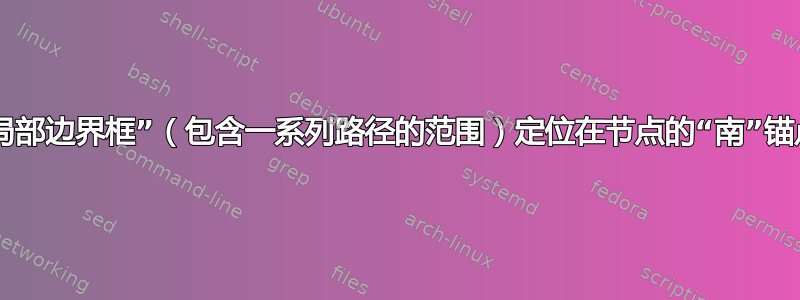
将节点置于 a 下方很容易local bounding box(行为是标准的),但反过来就不行了。我认为这是因为范围不“知道”它外面的节点。我尝试使用positioning库将范围的边界框放置在south其上方节点之一的锚点下方,但没有结果。我还尝试为边界框选择一个锚点(anchor=north),但得到了相同的结果(没有结果)。
\documentclass{standalone}
\usepackage{tikz}
\usetikzlibrary{calc}
\begin{document}
\begin{tikzpicture}
\path node
[ anchor=north west,
text width=50mm
](n1)
{ This is sentence 1. This is sentence 2. This is sentence 3.
};
% DRAWING SHOULD BE POSITIONED BELOW FOLLOWING NODE (n2)
\path node
[ anchor=north west,
text width=50mm
](n2)at(n1.south west)
{ \[2+2=4\]
};
% ------------- %
% DRAWING BELOW %
% ------------- %
\begin{scope}
[ scale=0.7,
local bounding box=smiley
]
\path node[anchor=north west](t1){DRAWING TITLE};
\path
[ draw,
radius=30pt
]($(t1.south)+(0,-30pt)$)circle;
\path
[ draw,
radius=5pt
]($(t1.south)+(-15pt,10pt)+(0,-30pt)$)circle;
\path
[ draw,
radius=5pt
]($(t1.south)+(15pt,10pt)+(0,-30pt)$)circle;
\path
[ draw,
line width=1pt
]($(t1.south)+(0,0)+(0,-30pt)$)--($(t1.south)+(0,10pt)+(0,-30pt)$);
\path[draw]($(t1.south)+(-10pt,-15pt)+(0,-30pt)$)rectangle($(t1.south)+(10pt,-5pt)+(0,-30pt)$);
\end{scope}
\end{tikzpicture}
\end{document}
在范围(名为“笑脸”的节点,即 )的\usetikzlibrary{positioning}前言和方括号(样式)中添加不起作用。below=0mm of n2.southlocal bounding box
使用shift反复试验的方法,这不是解决方案(我们需要smiley的north锚点精确地定位在n2的south锚点处)。

答案1
您可以使用[shift-(coordinate)]来定位范围的原点。然后只需相对于此原点定位范围的内容即可。
\documentclass{standalone}
\usepackage{tikz}
\usetikzlibrary{calc}
\begin{document}
\begin{tikzpicture}
\path node
[ anchor=north west,
text width=50mm
](n1)
{ This is sentence 1. This is sentence 2. This is sentence 3.
};
% DRAWING SHOULD BE POSITIONED BELOW FOLLOWING NODE (n2)
\path node
[ anchor=north west,
text width=50mm
](n2)at(n1.south west)
{ \[2+2=4\]
};
% ------------- %
% DRAWING BELOW %
% ------------- %
\begin{scope}
[ shift=(n2.south),
scale=0.7,
local bounding box=smiley
]
\path node[anchor=north](t1){DRAWING TITLE};
\path
[ draw,
radius=30pt
]($(t1.south)+(0,-30pt)$)circle;
\path
[ draw,
radius=5pt
]($(t1.south)+(-15pt,10pt)+(0,-30pt)$)circle;
\path
[ draw,
radius=5pt
]($(t1.south)+(15pt,10pt)+(0,-30pt)$)circle;
\path
[ draw,
line width=1pt
]($(t1.south)+(0,0)+(0,-30pt)$)--($(t1.south)+(0,10pt)+(0,-30pt)$);
\path[draw]($(t1.south)+(-10pt,-15pt)+(0,-30pt)$)rectangle($(t1.south)+(10pt,-5pt)+(0,-30pt)$);
\end{scope}
\end{tikzpicture}
\end{document}
答案2
我认为您目前还不能以这种方式定位局部边界框。但是,您可以将局部边界框的内容声明为图片,这是可行的(我必须补充一下,这在一定程度上是意外的)。
\documentclass{standalone}
\usepackage{tikz}
\usetikzlibrary{calc,positioning}
\begin{document}
\begin{tikzpicture}[smiley/.pic={code={
\path node[anchor=north](t1){DRAWING TITLE};
\path
[ draw,
radius=30pt
]($(t1.south)+(0,-30pt)$)circle;
\path
[ draw,
radius=5pt
]($(t1.south)+(-15pt,10pt)+(0,-30pt)$)circle;
\path
[ draw,
radius=5pt
]($(t1.south)+(15pt,10pt)+(0,-30pt)$)circle;
\path
[ draw,
line width=1pt
]($(t1.south)+(0,0)+(0,-30pt)$)--($(t1.south)+(0,10pt)+(0,-30pt)$);
\path[draw]($(t1.south)+(-10pt,-15pt)+(0,-30pt)$)rectangle($(t1.south)+(10pt,-5pt)+(0,-30pt)$);
}}]
\path node
[ anchor=north west,
text width=50mm
](n1)
{ This is sentence 1. This is sentence 2. This is sentence 3.
};
% DRAWING SHOULD BE POSITIONED BELOW FOLLOWING NODE (n2)
\path node
[ anchor=north west,
text width=50mm
](n2)at(n1.south west)
{ \[2+2=4\]
};
% ------------- %
% DRAWING BELOW %
% ------------- %
\pic[below=1ex of n2,scale=0.7] {smiley};
\end{tikzpicture}
\end{document}
当然,您可以使用来local bounding box相对于图片定位事物。
\documentclass{standalone}
\usepackage{tikz}
\usetikzlibrary{calc,positioning}
\begin{document}
\begin{tikzpicture}[smiley/.pic={code={
\begin{scope}[local bounding box=#1]
\path node[anchor=north](t1){DRAWING TITLE};
\path
[ draw,
radius=30pt
]($(t1.south)+(0,-30pt)$)circle;
\path
[ draw,
radius=5pt
]($(t1.south)+(-15pt,10pt)+(0,-30pt)$)circle;
\path
[ draw,
radius=5pt
]($(t1.south)+(15pt,10pt)+(0,-30pt)$)circle;
\path
[ draw,
line width=1pt
]($(t1.south)+(0,0)+(0,-30pt)$)--($(t1.south)+(0,10pt)+(0,-30pt)$);
\path[draw]($(t1.south)+(-10pt,-15pt)+(0,-30pt)$)rectangle($(t1.south)+(10pt,-5pt)+(0,-30pt)$);
\end{scope}
}}]
\path node
[ anchor=north west,
text width=50mm
](n1)
{ This is sentence 1. This is sentence 2. This is sentence 3.
};
% DRAWING SHOULD BE POSITIONED BELOW FOLLOWING NODE (n2)
\path node
[ anchor=north west,
text width=50mm
](n2)at(n1.south west)
{ \[2+2=4\]
};
% ------------- %
% DRAWING BELOW %
% ------------- %
\pic[below=1ex of n2,scale=0.7] {smiley=my smiley};
\node[below=1ex of my smiley]{I am below my smiley};
\end{tikzpicture}
\end{document}
答案3
由于笑脸只是一个里面有一些线条的圆圈,你可以用 将它画成一个圆形节点path picture。这样你就可以把它放在positioning库中,避免与图片相关的问题。
\documentclass{standalone}
\usepackage{tikz}
\usetikzlibrary{calc,positioning}
\begin{document}
\begin{tikzpicture}
\node
[ anchor=north west,
text width=50mm
](n1)
{ This is sentence 1. This is sentence 2. This is sentence 3.
};
% DRAWING SHOULD BE POSITIONED BELOW FOLLOWING NODE (n2)
\node
[ anchor=north west,
text width=50mm,
below= 5pt of n1
](n2)
{ \[2+2=4\]
};
% ------------- %
% DRAWING BELOW %
% ------------- %
\begin{scope}
[ scale=0.7, transform shape
]
\node[below=5pt of n2](t1){DRAWING TITLE};
\node[circle, minimum size=60pt, draw, below=5pt of t1,
path picture={
\draw (path picture bounding box.center)+(-15pt,10pt) circle (5pt);
\draw (path picture bounding box.center)+(15pt,10pt) circle (5pt);
\draw (path picture bounding box.center)--++(90:10pt);
\draw (path picture bounding box.center)+(-10pt,-15pt) rectangle ++(10pt,-5pt);
}
](smiley){};
\end{scope}
\end{tikzpicture}
\end{document}






